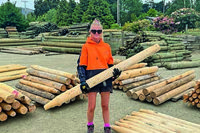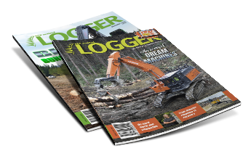
Asmall surviving timber mill near the rural West Otago township of Tapanui has battled on regardless of changing times, with some updated innovations.
Stuart’s Timber Company now supplies a wide range of products throughout the Southern provinces.
From the Queenstown Lakes District, Central Otago to Dunedin and Invercargill, wholesale building supply firms, farming communities and builders vie for the mill’s products.
These range from landscaping to structural framing, dressed timber, weatherboarding, garden, horticulture, and post and pole supplies.
The family business is headed by second generation, Roger Stuart, who believes the business is moving from small to more mid-sized.
Roger explains, “The company has almost done the full cycle, from manufacturing outdoor furniture to finger jointing, and laminating in the late 1980s and 90s. However, the Stuart family enterprise is now back to the basics of timber production.”
The past two decades have seen many local based saw mills winding up operations. Part of the reason was the demand for export logs making it marginal for local mills to compete, and a lot to do with modernised economy of scale manufacturing.
Also, the effects of globalisation, manufacturing of wood products by low wage economies such as China, India and South Korea put paid to local processing.
On top of that, the volume of wood harvested in this country exceeded demand of the Nation’s building industry at the time.
Nearby Ernslaw One’s Blue Mountain Lumber closed down about 15 years ago, as well as a couple of regional mills in Northern Southland
Stuart’s Timber Company is currently cashing in on the recent regional building boom, particularly in Central Otago, Wanaka and Queenstown.
Moving with the times
Roger, Managing Director, admits to tough times since the company’s launch back in 1980 by his father Campbell Stuart and his three brothers.
“It was a matter of modernising the plant where possible, and when funding was available,” Roger explains.
Gone was the old 60-inch breakdown saw and 44-inch breast bench, and in with the electronically mechanised band saw in 2005. One of the original twin flitch re-cutting breast benches will be replaced with more modern and efficient equipment. Cant hooks for positioning logs on the bench, are now implements of a past epoch.
Operating the head rig, mill hand, Max McCormack, says it does take a bit of concentration focusing on the operating machinery for any length of time.
“It’s a somewhat sedentary job so we move about the sawmill doing other tasks to remain active,” he told NZ Logger.
Management makes certain all employees are trained to handle the variety of mill jobs.
“We now have 38 permanent employees, of which seven are whanau and have become skilled in their jobs,” Roger says.
When it comes to job creation, the Tapanui district indicates how forestry and related industries benefit rural areas.
In effect this involves 25 families living around the township with the rest residing in nearby Gore.
“In some cases there are two or more working at the sawmill from the same families,” says Roger.
Logs are supplied from local woodlot owners and corporate foresters
The family must have taken something of a...






